Become an FAA Certified Drone Pilot to Fly for Commercial Use
This online/live 7.5 hour ground school course, originally developed by Mark Donovan for the University of New Hampshire’s Drone Academy, prepares students to pass the FAA Part 107 Remote Pilot Aeronautical Knowledge test. It provides in-depth training on the FAA’s Part 107 non-hobbyist small Unmanned Aircraft Systems (sUAS) rules and regulations, as well as all other knowledge areas of aviation required by the FAA, to become a certified Part 107 Remote Pilot and to operate a drone commercially in the United States National Airspace System.
Next class starts April 21st, 2025. Register below today!
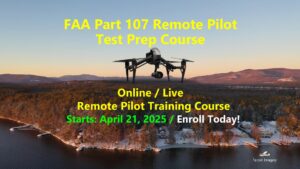
There are many online Part 107 Test Prep courses you can choose from. However, they’re generally taught by watching a series of pre-packaged videos, with no live interaction with an instructor to immediately answer any questions you may have as you attempt to learn the material. At Falcon Imagery we help students prepare for the FAA’s Part 107 Remote Pilot Knowledge test a little differently.
This Live/Online FAA Part 107 Remote Pilot Test Prep Course is taught by Mark Donovan, an FAA Part 107 Commercial Drone Pilot, and an FAA Part 61 manned aircraft Commercial Pilot and Certified Flight Instructor (CFI).
At Falcon Imagery, FAA Certified Flight Instructor (CFII) for manned aircraft, and Civil Air Patrol Mission Pilot and Check Pilot/Instructor Pilot, Mark Donovan, teaches the Part 107 Remote Pilot Test Prep course live. This enables students to interact directly with the instructor in a live classroom setting, either via an online Zoom meeting or at a physical location.
By participating in a live / online classroom environment, Falcon Imagery Remote Pilot students more quickly grasp the complicated subject matter areas required on the FAA’s Remote Pilot Knowledge test. Specifically, subject matters such as:
- Understanding the National Air Space System and all its Classifications
- Calculating Weight and Balance of a drone
- Interpreting aviation weather resources such as METARs and TAFs
- Reading Aviation Sectional Charts
By the end of the 7.5 hour course, Falcon Imagery Remote Pilot students have a much better understanding of the technical subject matters that they need to master for passing the FAA Remote Pilot Exam, than if they had studied independently watching hours upon hours of a video series of the same material.
This course is designed for hobbyist drone pilots, and others working in industry and law enforcement required to fly drones, who are looking to become FAA Part 107 Remote Pilots so that they can fly drones commercially and safely in the United States National Airspace System. The course is in direct alignment with the FAA’s Part 107 remote pilot certification requirements and includes the latest in 2021 regulation changes.
This is a Live / Online course, where the instructor and students directly interact with each other during the classes.
Topics covered in detailed during the 107 Remote Pilot course include:
- Part 107 Remote Pilot Certification Requirements
- Part 107 Aeronautical Knowledge Test General Information
- Scheduling to take the Part 107 Remote Pilot Aeronautical Knowledge Exam
- Application Process for Obtaining a Part 107 Remote Pilot Certificate
- Applicable FAA Documents and Regulations Associated with sUAS
- New Part 107 Rules – Effective April 21, 2021
- Airspace classification, ops requirements and flight restrictions affecting sUAS ops
- Aviation weather sources
- Effects of weather on sUAS performance
- sUAS loading
- Emergency procedures
- Crew Resource Management
- Radio Communication Procedures
- Determining the Performance of sUAS
- Physiological effects on Pilot Performance
- Aeronautical Decision-Making and Judgment
- Airport Operations
- Night Operations
- Maintenance and Pre-flight Inspection Procedures
Practice test questions are introduced at the end of each course chapter.
Emphasis Topics covered in the Part 107 Remote Pilot Course Include:
| How to Read Sectional Charts
There’s a wealth of information on an FAA Sectional Chart that can ensure you fly your drone safely and avoid manned aircraft. This Part 107 remote pilot course provides detailed discussion on interpreting them. |
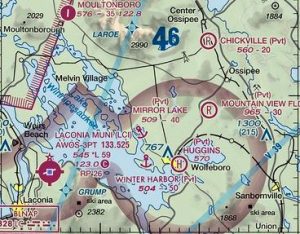 |
| National Airspace System
Our nation’s airspace is comprised of controlled and uncontrolled airspace, as well as special use and “other” airspace. Knowing where you can legally fly a drone is important for a remote pilot. This course provides in-depth discussion on this topic. |
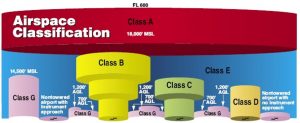 |
| New 2021 Part 107 Rules
Many new Part 107 rules became effective April, 2021, including:
|
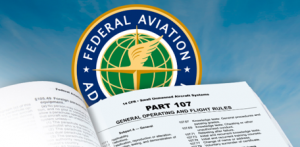 |
| Aviation Weather
Up to 16% of the Remote Pilot Aeronautical Written Exam can be on weather. This course provides in-depth review on:
|
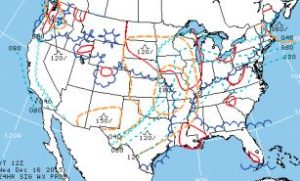 |
By the end of this online / Live Part 107 Remote Pilot course students will be prepared to successfully pass the FAA Remote Pilot Aeronautical Knowledge Test.
In addition to in-depth training on the Part 107 FAA rules and regulations, students will be introduced to the various sUAS-related careers paths that become available to them after receiving their Part 107 Remote Pilot Certificate from the FAA.
Drone Pilot Course Details – This Part 107 drone pilot course is taught live and interactively with the instructor via an online Zoom classroom environment.
Course Dates – This course is taught over three nights during a one week span, in two and one half hour sessions. The next course starts Monday, April 21st, 2025 (6:00pm to 8:30pm EDT), with the two additional classes that follow on April 23rd and April 28th at the same time (6:30pm to 8:30pm). Custom dates are also an option!
Individual Course Cost – $189
To enroll in this course, simply click on the Buy Now Button above to use either a PayPal account, or a credit card, and process securely through PayPal.
Do you have a team requiring Part 107 certification? Group discount rates are available for teams of two or more, with increasing discounts the larger the team.
Do you have specific date(s) availability? Reach out and we can often accommodate your schedule.
If you have further questions about this course, contact us here.
Lifetime Access – To maintain your FAA Part 107 Remote Pilot license, you’ll need to pass a free recurrent FAA knowledge test every 24 months. Students of this course will receive lifetime access to the online training course material, which is updated regularly in response to FAA Part 107 rule changes.
Help When you Need it – If you have any questions after completing our live / online FAA Part 107 Course, simply call or email us, and we will respond back to you quickly.
– Testimonials –
|
Tim R.: September 19, 2019 Mark, Thanks for the help today, I passed the Part 107 test with a 97%. Eric S.: February 21, 2020 Mark, This morning I took my Part 107 UAS – Small exam and PASSED with a score of 88%.Thank you for the course it gave me a great base of knowledge. Marc B.: March 12, 2021 Mark, Thank you for your class. Appreciated all the information, explanations and insights you provided – now I know what I’m in for! Brian W.: December 1, 2021 Mark, Just finished my test with a 90. Thanks for your help yesterday, it clarified my question. I found the material you covered very relevant to the test I just completed, though I still needed to study more. I also appreciated that you were available and interested to answer my questions weeks after I took the course. That was huge. |
Instructor Background – Mark Donovan
- University of New Hampshire Adjunct Instructor who developed the course material and has taught the same FAA Part 107 Workshop from 2018 to present.
- Part 107 certified small Unmanned Aircraft Systems (sUAS) remote/drone pilot.
- Part 61 Certified Flight Instructor (CFI/CFII), Commercial and Instrument rated pilot, manned aircraft.
- Consultant to other online Part 107 Drone Schools
- Mission Pilot & Instructor/Check pilot for New Hampshire Wing Civil Air Patrol
- Falcon Imagery owner – sUAS company founded in 2016.
- 38 years in high tech working in various Electrical Engineering and Technical Marketing positions.
